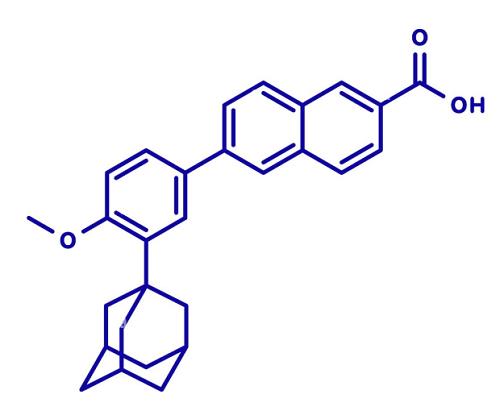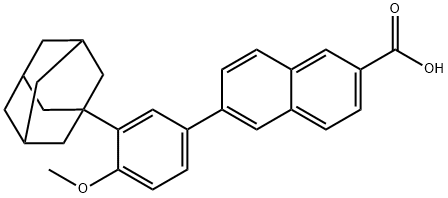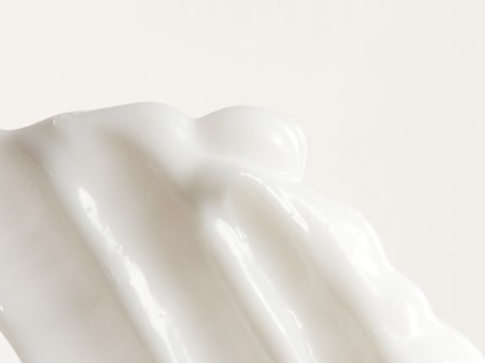Adapalene: Skin conditions treatments
Basic Introduction
Adapalene is a topical retinoid that is FDA-approved for treating acne vulgaris. Like other retinoids, adapalene has been used off-label for various skin conditions, including verrucae, molluscum contagiosum, Darier disease, Fox-Fordyce disease, Dowling-Degos disease, photoaging, pigmentary disorders such as melasma and post-inflammatory hyperpigmentation, actinic keratoses, and alopecia areata. Additionally, adapalene and adapalene analogs are investigated for potential anti-microbial, anti-cancer, and neuroprotective effects. Adapalene was initially FDA-approved in 1996 for acne in patients 12 years of age or older. The FDA-approved adapalene 0.1% gel as an over-the-counter acne treatment in patients 12 and older in 2016. Formulations of adapalene 0.1% lotion, cream, and 0.3% gel are available by prescription only. Retinoids are vitamin A derivatives that are typically described in terms of generations with increased specificity of retinoic acid receptor (RAR) affinity with later generations. Adapalene is a third-generation synthetic retinoid developed to improve the side effect profile compared to tretinoin. This first-generation topical retinoid more closely resembles natural vitamin A in structure. Second-generation retinoids are oral medications. [1]

Efficacy and Tolerability of Adapalene
Despite these conventions, studies support that adapalene is more efficacious in treating acne vulgaris than other retinoids. A meta-analysis including five randomized controlled trials suggested that adapalene 0.1% gel had similar efficacy but enhanced tolerability in acne treatment compared to tretinoin 0.025% gel. Adapalene has also been compared to tretinoin in a vehicle formulation of microsphere gel, which allows for tretinoin to be delivered primarily to the epidermis to decrease irritation and increase tolerability. A randomized controlled trial of tolerability, safety, and efficacy of adapalene gel 0.1% and tretinoin 0.1% microsphere gel revealed that the efficacy was comparable in total, non-inflammatory, and inflammatory lesions. However, the adapalene patient group exhibited significantly enhanced cutaneous tolerability. Adapalene also performs well when compared to tazarotene. In a 12-week randomized, evaluator-blinded study comparing adapalene 0.3% gel and tazarotene 0.1% gel, each group had a clinically significant reduction in total lesion counts. A 61% reduction in acne lesions occurred with the administration of adapalene, with a 57% reduction in the tazarotene group. Adapalene, 0.3% gel, had equivalent efficacy to tazarotene 0.1% gel. However, patients using adapalene experienced less irritation than patients in the tazarotene-treated group. Adapalene has additional advantages when compared to other retinoids. Adapalene is a more stable molecule, which leads to less concern for molecular photodegradation, allowing for use during daylight hours. This stability contrasts with both tretinoin and tazarotene, which are photolabile. The stability of adapalene allows for use in combination with benzoyl peroxide, which has a synergist effect. A randomized double-blinded study of topical adapalene 0.3%-benzoyl peroxide 2.5% demonstrated significantly greater efficacy in patients with moderate-to-severe inflammatory, non-nodulocystic acne. With the synergistic effect of benzoyl peroxide, adapalene 0.3% increases patient treatment options for moderate to severe acne.[2]
Mechanism of Action
Adapalene is a third-generation topical retinoid prescribed for the treatment of acne vulgaris. Adapalene is a naphthoic acid derivative designed to be more structurally rigid than previous retinoid generations, which decreases its ability to bind multiple retinoid receptors, thus reducing off-target effects. Adapalene is an active metabolite and therefore requires no metabolic conversion. The adamantane nucleus is the chemical moiety that allows adapalene to attach to RAR-beta and RAR-gamma. This complex binds DNA through retinoic acid response elements and induces gene transcription, leading to downstream keratinocyte proliferation and differentiation. As a result, adapalene decreases microcomedone formations, exfoliates mature comedones, and has anti-inflammatory effects. Of note, the adamantane nucleus is a component found in multiple other drugs, including antivirals and anti-hypoglycemic agents. Adapalene and newer analogs are under investigation for new potential therapeutic uses due to the antiproliferative, antibacterial, and neuroprotective activity attributed to the adamantane moiety. The pathogenesis of acne vulgaris is multifactorial. However, the main factors associated with acneiform lesion development are follicular hyperkeratinization, sebum production by sebaceous glands, and inflammation. In acne-prone patients, keratinocytes accumulate in the lumen of the hair follicle due to increased keratinocyte proliferation and cohesiveness, leading to the formation of a keratotic plug, resulting in the microcomedone. The microcomedone is the precursor to all visible acne lesions like open comedones, closed comedones, inflammatory papules, pustules, and nodulocystic lesions.
Adapalene normalizes the differentiation of follicular epithelial cells to prevent microcomedone formation. In addition, adapalene, when applied topically, penetrates the hair follicles due to its lipophilic nature. In addition to follicular hyperkeratinization, acne is also a disorder associated with inflammation. Propionibacterium acnes is a gram-positive, anaerobic rod found in the sebaceous follicle. P. acnes is present in both acne-prone individuals and those without acne. The hypothesis is that there may be differences in the strains of P. acnes or in the host response to P. acnes, which leads to its varying degrees of pathogenicity. P. acnes release mediators that contribute to comedones rupture and stimulate inflammatory cells. P. acnes stimulates the toll-like receptor II (TLR-2) pathway, which releases pro-inflammatory modulators. This action leads to neutrophil recruitment and the release of enzymes that result in follicular epithelium rupture. One mediator, IL-12, promotes a TH1 immune response. Adapalene is thought to suppress polymorphonuclear lymphocyte chemotaxis and down-regulate 15-lipoxygenase and TLR-2, contributing to its anti-inflammatory effects. The anti-inflammatory action of adapalene is comparable to betamethasone-17-valerate and indomethacin.[3]
Adverse Effects
Adverse reactions reported from adapalene include photosensitivity, irritation, redness, dryness, itching, and burning. These are usually mild adverse events. Adapalene is less irritating compared to other topical retinoids. In a blinded, randomized, controlled, parallel-group study of 591 acne patients, a combined safety analysis conducted in the United States and Europe compared adapalene 0.1% gel and tretinoin 0.025% gel. The number of patients discontinuing the study due to adverse events was about twice as high in those using tretinoin compared to adapalene. There were no systemic adverse reactions noted in the study. Most of the adverse reactions observed were related to skin irritation. Multiple other studies have demonstrated similar findings. Adapalene 0.1% and 0.3% have also been compared to tazarotene in multiple studies showing adapalene to be non-inferior in efficacy and demonstrated superior tolerability. The enhanced tolerability of adapalene has been attributed, in part, to the selective affinity to the nuclear RAR-beta and RAR-gamma receptors, as opposed to RAR-alpha. The decreased risk of skin irritation may contribute to better long-term compliance. Exposure to ultraviolet light should be minimized in patients using adapalene gel. Patients exposed to high levels of sun exposure and sensitive to sunlight should exercise caution.
References
[1] Tan J, Bissonnette R, Gratton D, Kerrouche N, Canosa JM. The safety and efficacy of four different fixed combination regimens of adapalene 0.1%/benzoyl peroxide 2.5% gel for the treatment of acne vulgaris: results from a randomised controlled study. Eur J Dermatol. 2018 Aug 01;28(4):502-508.
[2] Bagatin E, Gonçalves HS, Sato M, Almeida LMC, Miot HA. Comparable efficacy of adapalene 0.3% gel and tretinoin 0.05% cream as treatment for cutaneous photoaging. Eur J Dermatol. 2018 Jun 01;28(3):343-350.
[3] Rusu A, Tanase C, Pascu GA, Todoran N. Recent Advances Regarding the Therapeutic Potential of Adapalene. Pharmaceuticals (Basel). 2020 Aug 28;13(9)
You may like
Related articles And Qustion
See also
Lastest Price from Adapalene manufacturers

US $0.00-0.00/kg2025-07-18
- CAS:
- 106685-40-9
- Min. Order:
- 1kg
- Purity:
- 98%min
- Supply Ability:
- 1000g

US $10.00/KG2025-04-21
- CAS:
- 106685-40-9
- Min. Order:
- 1KG
- Purity:
- 99%
- Supply Ability:
- 10 mt



